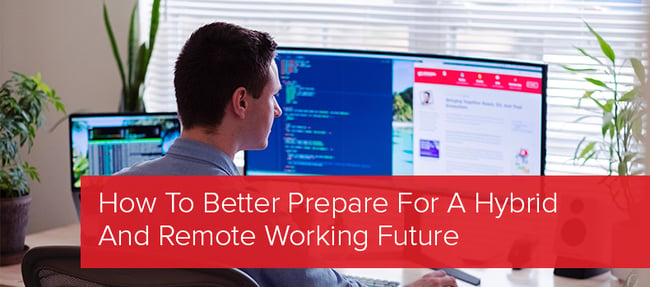Hybrid and remote working options are no longer a choice for many companies, they’re ways of working that have to be embraced, optimised and prepared for.
2020 and the first half of 2021 need to be viewed as a test to see what worked and what didn’t, rather than seeing it as an emergency measure for unpredictable events.
In the UK, there has already been talk about making ‘work from home’ a ‘default’ option in which employees can choose where they want to work, unless there is a reason they shouldn’t.
Changes at a national level indicate that this ‘trend’ is something that is here to stay and needs to be dealt with and prepared for properly.

How can management in your company prepare?
There are 4 key actions that every company can review and look at today with the idea that it will help prepare the business for the future and for a hybrid workforce:
- Review business data and take actions based on the insights that show what’s happening in the business - whether it’s reviewing how devices are being utilised or assessing inefficient processes, data doesn’t lie and needs to be considered when making decisions.
- Support productivity measures for flexible working - there’s been a lot of evidence over the last couple of years to support the idea that people are as productive and sometimes more productive working remotely. To ensure this remains true, provide opportunities for people to choose how, when and where they work (within reason) to ensure higher levels of productivity.
- Accelerate your digital transformation strategy by digitising and moving business processes to the cloud. This allows people to access business systems wherever they’re working from and provides a level of business continuity if for any reason the office becomes unavailable. Cloud-based systems also allow for more scalability in the future.
- Secure all devices and processes from end-to-end. With hybrid and remote working, employees won’t always have the luxury of being on a secure office network. That means putting in place both process and solid device security to ensure no information is breached.
These four actions help to support a hybrid working strategy by allowing employees to choose their way of working productively, providing easy access to systems while remaining secure when not in the office and allows management to review the data and see what’s working and what’s not.
Questions to consider
In order to prepare for hybrid and remote working, consider the following questions:
- Do employees have devices that allow them to work from anywhere? (including the office)
- Are all of our key business processes available via cloud-based software and applications?
- Does everyone have access to the software and tools they need when not working in the office? (CRM, ERP, LOB applications, Document Management etc.)
- Is the company set up for remote collaboration between employees?
- Can IT remotely manage all company devices?
- Can employees print at home and is printing recorded on the company’s print management platform?
- Are customer communications dealt with properly and promptly regardless of employee location?
These questions are just a subset of the bigger picture but can help lead the strategy and help open up to other important questions that need to be answered.
Xenith provide a suite of solutions that help support mobile, remote and hybrid workers and ensure you’re prepared for the future hybrid working world, with everything your staff need in order to be productive & efficient while working remotely - laying the foundation for a more digitally-led organisation upon business-as-usual.

